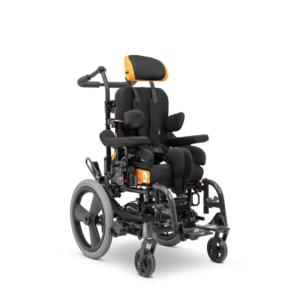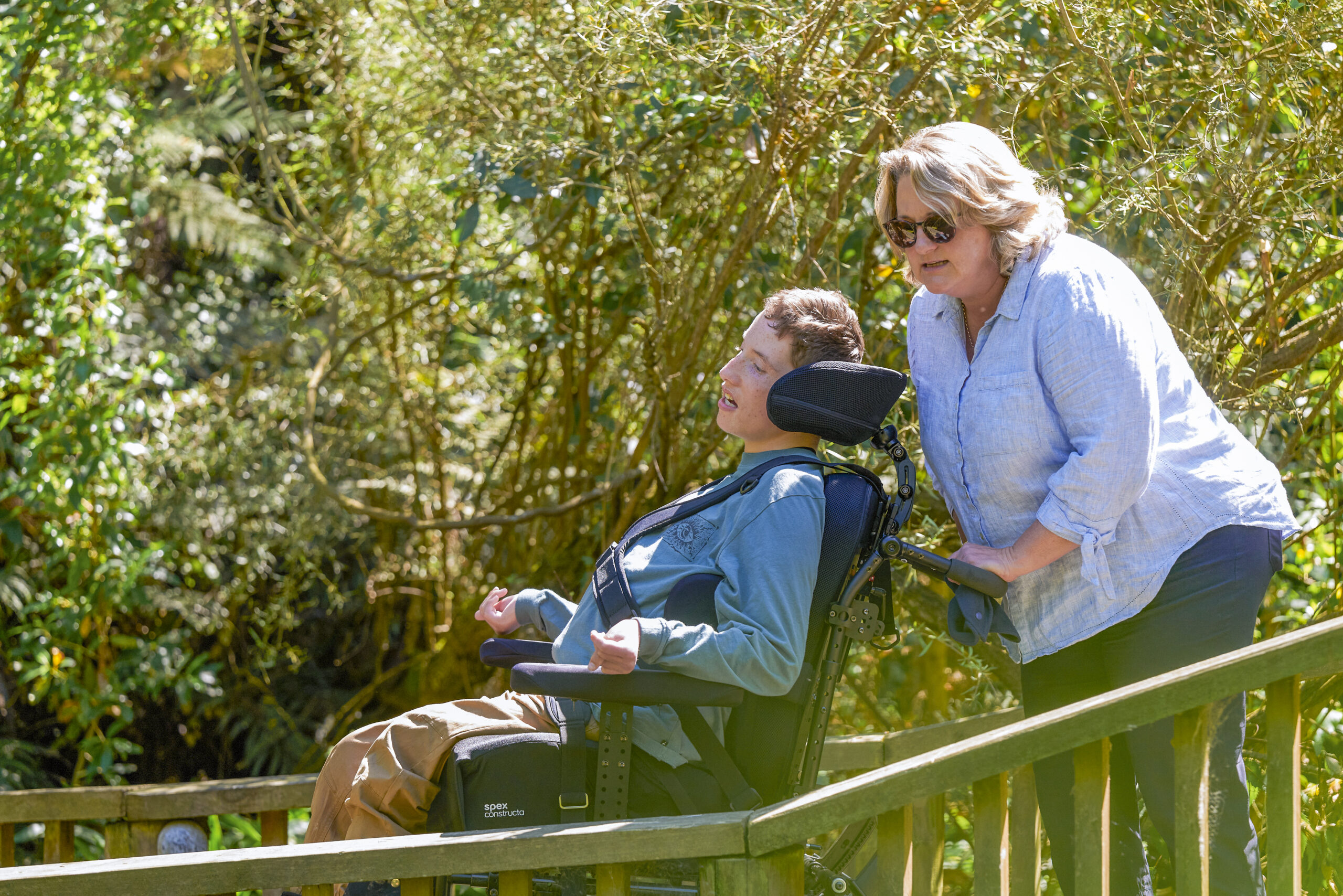Nine case studies were carried out trialling the new Constructa Shape and Constructa Flex cushions. Where possible pressure mapping was completed, comparing the participant’s current setup with the trial setups. The local reps were given basic training on the products before leading the setup of them and were supported by a member of the design team wherever possible.
Therapists completed their usual MAT assessments, identifying areas of support or accommodation of fixed deformities needed. Once identified, the rep adjusted the trial cushion. Most initial setups were achieved on the first go, meaning fewer transfers were needed, with some of the more complex ones needing some minor adjustments. The majority were achieved in a single visit. This greatly reduces the need for multiple visits or transfers with a high success rate of achieving a comfortable, supportive posture with reduced peak pressures in a shorter time span.
During each setup, eight steps were followed.
- The overlay was detached.
- The inner cover was removed.
- The positioning blocks/components were adjusted.
- The cushion was reviewed on the plinth or chair (overlay was laid on top of the positioning base).
- The positioning blocks/components were adjusted (If needed).
- The inner cover was fitted.
- The overlay was attached.
- The outer cover was fitted
With a simple eight-step process in place, it ensured good consistency between trials.
It was clear by the end of all nine studies that using these products decreased lead times on the provision of the cushions and an “off the- shelf, custom cushion” was achieved. Out of the nine participants, seven are still sitting on their Constructa cushions with one awaiting a new wider wheelchair before going back onto a Constructa cushion, and one needing more pressure relief than was achievable due to healing a current pressure injury. It was noted that the Constructa cushion held this lady in a better sitting position, but she needed to sit fully on air for her pressure injury to heal. Feedback from all participants was positive.
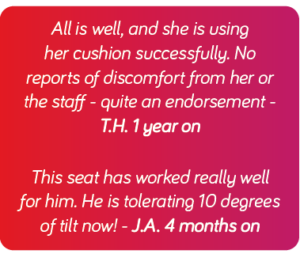
What Postural Deformities Were Addressed During the Trials?
• Flexion deformities of the hip.
• Leg length discrepancies.
• External rotation deformities of the hip.
• Fixed abduction of the hips.
• Windsweeping.
• Pelvic obliquities.
The trials also showed that participants who would usually slide forward on their cushions were able to sit with their ischia in the ischial well. The cushions also prevented the tendency to move into posterior pelvic tilt by locking the pelvis behind the pre-ischial shelf and providing good support surrounding it. Where pressure mapping was completed, peak pressures were lower with the Constructa cushions as opposed to other fully customised cushions.
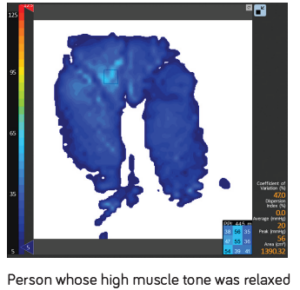
A Final Wrap-Up of What These Case Studies Highlighted.
- Quick setup of an off-the-shelf, custom cushion.
- Easy setup. Only basic knowledge of the product is needed to achieve a comfortable, supportive sitting posture. The therapist lists what they want to achieve, and the rep configures the cushion.
- Due to the wide range of components with multiple shapes, sizes, and contours, unique ways of supporting users’ postures can be achieved.
- With the overlay system, small gaps between seating components can be bridged with no adverse effects. More adjustability can be achieved with one kit.
- The three-cover system allows for a wide range of cushion heights, widths, and lengths to be accommodated by a single cover without compromising the surface the user sits on. There is no hammocking of the cover and the potential wrinkles/ creases from the inner cover are not felt by the user due to the smooth overlay.
- The novel cutaways and contours of some of the component pieces allow for greater immersion and increased surface contact in turn reducing peak pressures.
- There is a huge amount of customisation possible with both cushions in one handy kit.
These cushions have a unique three-cover design. Due to the inner cover not being in contact with the user, they can be made slightly bigger to accommodate a wide range of adjustments in cushion height, length, and width. This was demonstrated in the trials as standard, high, and superhigh contours were achieved using the same cover in turn reducing the need for custom covers which would slow down the process.
It also contains the adjustable components of the cushion to reduce the risk of people other than the therapist/rep adjusting it. A handy layer of protection from unwanted adjustments. The overlay has a separate cover. This rests on top of any potential wrinkles and creases from the inner cover, creating a smooth surface for the user to sit on. Both the inner and overlay covers protect the seating components from deterioration due to liquid damage. The top surface of the outer cover is made of stretchy Lycra with a breathable, 3D spacer fabric underneath. This is the same fabric used in the Spex Classic cushion and can easily be laundered. Due to the three-cover system, there were no increased pressure readings caused by creases in the covers during the trials.
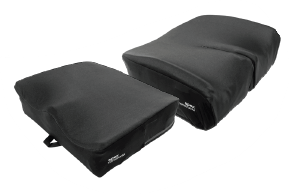
The new ‘Puzzle Joint’ in the Constructa Flex allows for some adjustment for leg length discrepancies of up to 1” without the need to cut the seating components. It can also give support to fixed hip abduction deformities without the need for a wedge to force the legs apart.
Windsweeping is another deformity that can be supported with the Constructa Flex cushion. These were all achieved in the trials.
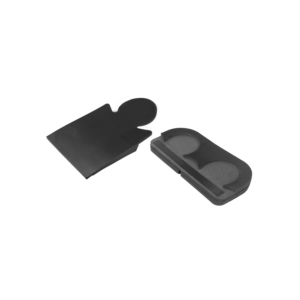
Constructa Flex Positioning base can help with leg length discrepancies
The Flexy Contour is a new accessory available, providing posterior support at the pelvis. With the V-cutouts, it can be shaped to fit the contour of the user’s posterior pelvis and in conjunction with a well adjusted back support can assist in maintaining the ischia in the ischial well. This was utilized during the trial process.
The angled cut of the Trochanter Block creates a smooth transition to the ischial well. This in turn eliminates the risk of increased pressures in this area demonstrated by the trial pressure mapping.
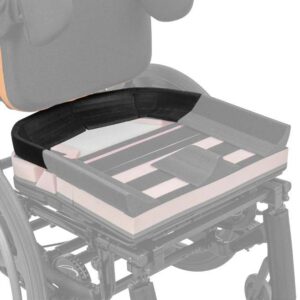
The Flexy Contour is a new Constructa Cushion Accessory available.
The Constructa Shape and Constructa Flex cushions were able to be modified to accommodate several tricky anatomical limitations that are usually beyond an off-the-shelf product. And once the pelvis, hips, and thighs were positioned and supported this had a knock on effect on the rest of the body. Back supports, head supports, arm supports, and foot supports all needed to be adjusted. In one case the new position helped to relax the participant’s muscle tone allowing her knees to flex where
previously they were more extended. This meant new foot supports tucking the feet closer to the chair were needed.
Download the flyer below!

